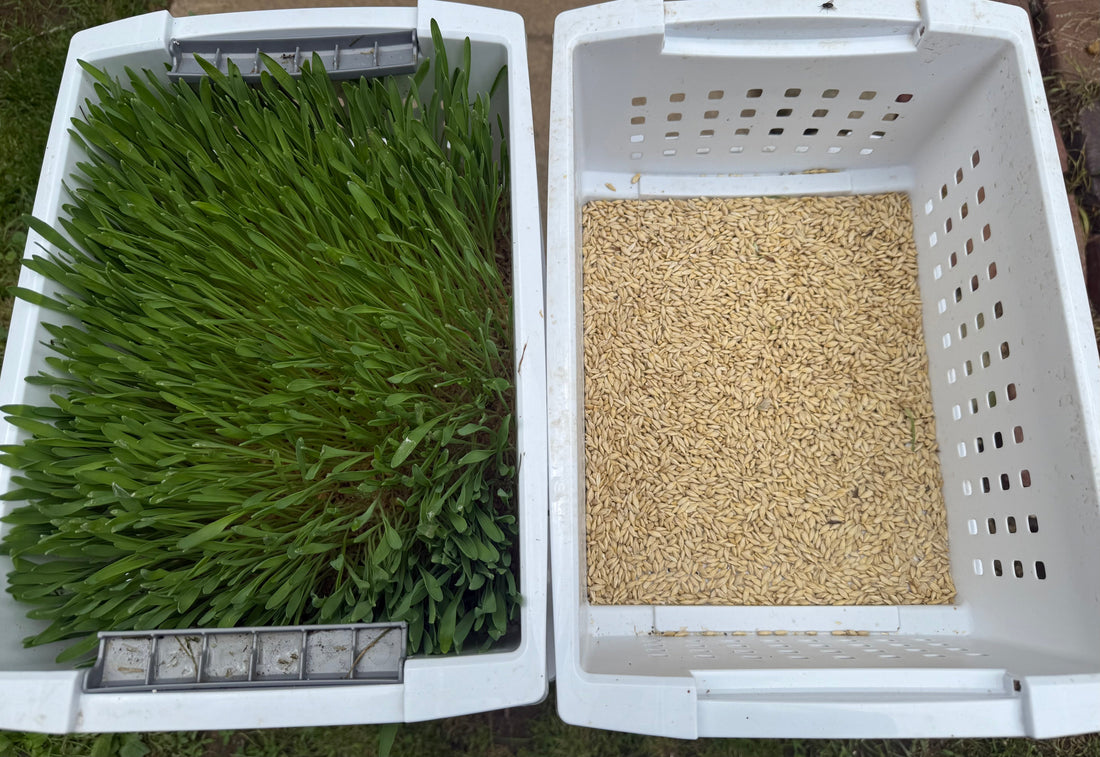
What is fodder? How to turn grains into fresh feed for livestock
Share
Let’s face it—we are always looking for a more affordable way to feed our livestock without sacrificing nutrition. Keeping animals happy and thriving is the goal. I stumbled upon fodder a few years back, and I haven’t looked back since. It’s a nutrient-dense way to feed animals, and I mainly use it to supplement my rabbits and chickens. Fodder shouldn’t be fed as a complete ration, but as a supplement it shines—especially for chickens that can’t free-range.
Fodder is simply sprouted grain. Depending on the type, it’s usually ready within 7–10 days. I prefer barley and wheat for their high nutritional value. Sprouting breaks down starches into simpler sugars and softens fiber, making it easier to digest. It also boosts vitamins like vitamin C, carotene (pro-vitamin A), and certain B vitamins. Barley contains about 12–14% crude protein, while wheat runs 13–15%. Sprouting increases the availability of amino acids, improving protein quality.
Sprouting also reduces fiber, giving fodder a lower Neutral Detergent Fiber (NDF) and Acid Detergent Fiber (ADF) than whole grain, which makes it even easier to digest. It improves mineral bioavailability by reducing phytic acid, making nutrients like calcium, phosphorus, magnesium, potassium, iron, and zinc more accessible. The result? A highly digestible, palatable feed animals love.
One of the best parts about fodder is that it requires no fancy equipment. If you have trays and seeds, you can start today. I use two systems. The first is a cart with five trays. The top tray has holes for drainage, and each tray stays covered until the fodder grows too tall. Once it’s ready, I feed the entire tray—roots and all.
My second system is a bit different. I simply took some baskets and drilled small holes in the bottom. Small enough for water to drain and keep the seeds in place. Any basket or tray will do. The baskets I used (they can be found on amazon) stack, which makes it easier. If you are using traditional grower trays, you can drill holes in the bottom and place them on a shelf where the water can drain. The point is for the water to drain from the top trays and trickle down into the bottom trays—watering all the trays. Depending on how many animals you are feeding, you’ll need to act accordingly on how much fodder you sprout. For chickens, one 12”x8” tray will feed roughly 10 chickens (as a supplement).
The process is simple: soak grains in water for 6–12 hours, then rinse and drain. I use 1–2 cups of grain per tray, enough to cover the bottom without overcrowding. From days 2–10, rinse and drain twice daily. Direct sunlight isn’t necessary, but it helps. Around day three, you’ll notice “hairs” on the grains—these are root hairs, not mold. Mold becomes an issue only if drainage is poor, humidity is too high, or airflow is lacking.
By days 7–10, the fodder is ready to feed. For rabbits, introduce it gradually, a handful at a time, to avoid digestive upset. Fodder should make up no more than 20% of an animal’s daily diet.
Animals typically eat fodder completely—roots and all—which cuts down on waste. By replacing up to 20% of their dry feed, you save money and provide fresh greens year-round.
The most common question is: Where do I buy grain? I prefer Azure Standard for price and quality. In the U.S., I can get a 45-lb bag of organic barley for $19.54 and a 50-lb bag of organic wheat (feed grade) for $36.90. One pound of grain yields 6–8 pounds of fodder. While most of that weight is water, the nutrition in itself is worth it. Barley tends to be the more affordable option. Amazon also carries grain, but it’s usually pricier than Azure Standard.
Fodder provides fresh, green feed regardless of weather or season. It boosts nutrition, reduces waste, and my animals thrive on it. Chickens and rabbits both look forward to their daily trays. If you pair feeding fodder with fermented feed for chickens, then the savings really start rolling in.
If you want a steady supply, stagger your trays—start a few one day, then add more the next. Before long, you’ll have fresh fodder available every day. At the end of the day, growing fodder is one more way to be less dependent on the feed store and more in control of your homestead. Start with a single tray this week and watch your flock enjoy fresh greens every day — it’s easier than you think!
This post contains affiliate links. I may earn a commission if you make a purchase through these links.
Sprouting trays- https://amzn.to/3KNHx9O
Organic barley grains- https://www.azurestandard.com/shop/product/outdoor-garden/animal-feed/farm-stock/barley/whole-barley-animal-feed-organic/11698?package=GP168&a_aid=9d278aedb6
Organic chicken wheat- https://www.azurestandard.com/shop/product/outdoor-garden/animal-feed/chicken/wheat/chicken-wheat-animal-feed-organic/7134?package=GP073&a_aid=9d278aedb6

1 comment
I’ve been doing research on sprouting wheat and grains for chickens. I really like the idea. Thank you for the information.